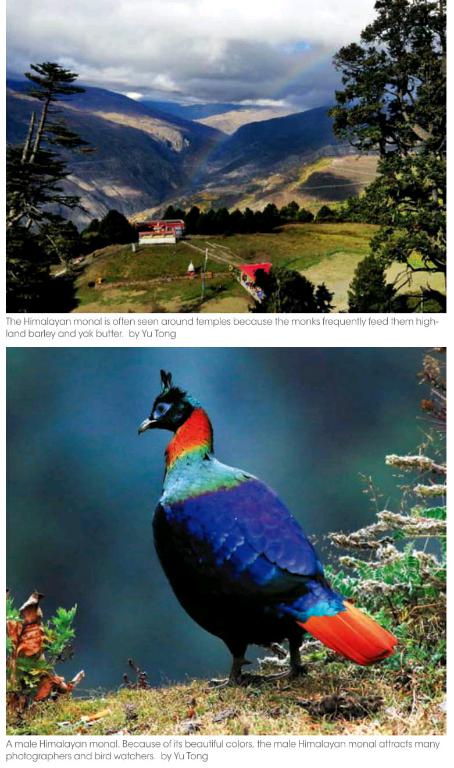Friendly Fowl
2016-03-17byYuTong
by+Yu+Tong
In 1790, English ecologist, writer and doctor John Latham named a bird he discovered in Nepal the “Himalayan monal (Lophophorus impejanus)” and identified it as a member of the pheasant family. Thanks to its large population of the pheasant genera of Phasianidae, China has been dubbed a “Kingdom of Pheasants.” However, the population of the Himalayan monal in China is less than 1,000, scattered mainly in southern and southeastern Tibet Autonomous Region. Because of its beautiful bright feathers, the Himalayan monal is also known as the“nine-colored bird.” With a body length of about 70 centimeters, the male monal wears colorful feathers and a peacock-like crest, while the female monal is brown.
In southern Tibet, the Himalayan monal is often seen around temples, where its population density is 2.03 per square kilometer, much heavier than the average of 0.052 per square kilometers. This phenomenon is attributed to the fact that monks like to feed the birds highland barley and yak butter. Each morning, the birds climb ridges of fields and walk or jump along the road to temples to eat the foods put out by the monks. After the dinner, they jump away or slide to cliffs they inhabit. At night, they usually fly into the trees on the cliff to rest. Due to its beautiful colors, the Himalayan monal is a popular target for photographers and bird watchers. Sometimes, monks even take pictures of the birds, talk with bird enthusiasts and guide them to see the animals without disturbing them.
Still, human activity has already affected the Himalayan monal. The species is on the 2012 Red List of the International Union for Conservation of Nature and Natural Resources (IUCN) and among 29 endangered pheasants worldwide. In China, land reclamation for farming and yak grazing has destroyed the habitat of the birds. Also, deforestation, hunting and nest poaching threaten the survival of the Himalayan monal.
As early as the 1980s, Zheng Zuoxin, pioneer of modern Chinese bird research, pointed out that the research and protection of Chinas birds should put emphasis on pheasants, cranes and birds of prey. Pheasants are categorized as a ground-dwelling resident bird. They are often large and the males are draped in bright feathers, which attracts mates as well as both admirers and hunters. These birds are closely related to humans, so they are priority among priorities in terms of protection.
Currently, Tibet has set up 47 nature reserves, with most habitats for the Himalayan monal covered. However, the animal still lacks a special protection program.“Because there are many species with small numbers like the Himalayan monal, we cannot establish a reserve for each kind,”explains Li Xiangtao, executive member of China Ornithological Society, a branch of the China Zoological Society. “Actually, many protection areas cover the birds habitat. So its present situation is not bad.”
Located at high altitudes, the Himalayan monals habitat usually features flourishing forests and steep, rocky landforms. Its hard for people to get close to them. So, in days past, little research had been conducted on the wild bird. As a cultural hub of the region, southern Tibet is home to many holy mountains, lakes and lands which draw numerous pilgrims and tourists. This also impacts the life of the birds. Today, monks are still shouldering the responsibility of guiding tourists and protecting the birds.
To protect pheasants, the Chinese government has adopted “on-site conservation,” “off-site conservation” and “reintroduction.” As early as 1989, the Himalayan monal was listed as a national first-class protected animal. At present, the bird is mainly in on-site conservation – grazing land for yaks and farmland are organized to leave enough living and productive space for the bird.